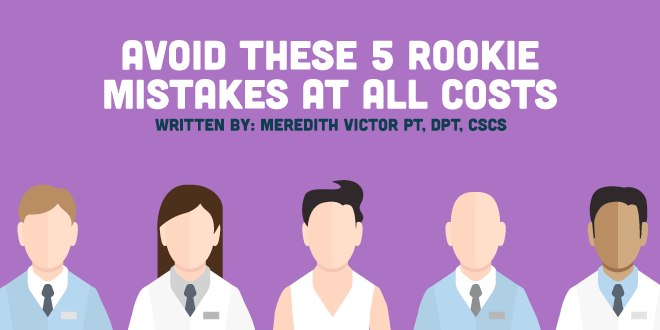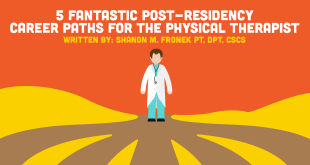Fresh PTs have a lot to offer. Enthusiastic and flexible, new grads can revive a clinic’s stagnant culture, and bring fresh ideas and energy to a rehab team. For a team looking to mentor an eager clinician, new graduates provide the ideal protege. In order to be the ideal protege for your clinic, avoid these rookie PT mistakes!
Don’t be that PT.
We realize that you may have had landed a job in a setting in which you haven’t worked. Perhaps you’re seeing more patients per hour than you ever saw during your clinicals. If you’re nervous, you’re in the right place, because we want you to feel confident and professional in your new role.
We polled our colleagues and supervisors and learned that, by avoiding these 5 common new PT mistakes, you can ensure that your boss will be thrilled to have hired you 🙂
Rookie PT Mistake #1: Overusing manual therapy
School taught us that putting our hands on a patient can be a truly therapeutic experience. Any good PT also knows that manual therapy is an integral part of our profession and sets us apart from other exercise professionals. New grads are generally just dying to break out all those cool manual techniques we learned; we are eager to improve our patients’ joint mobility, decrease their tissue tension, and relieve their pain. Unfortunately, though, if you overdo it with the manual therapy, two things can happen.
1. Your patients won’t stay better.
Sure, they may feel better after you treat the tissue tension in the TFL, but if you don’t strengthen the glutes and increase the stability of the ankle, that TFL is going to tighten right back up and need the same treatment over..and over…and over. That’s great for our bank accounts, but not so much for our patients’ health or our professional integrity.
2. Your patients won’t want to exercise.
Get those patients too cozy with 25 minutes of upper trap soft tissue mobilization, and you’re going to have a hard time getting them moving in the gym. This doesn’t apply to all patients, especially athletes, but it applies to a lot of folks who enter the clinic with the preconceived notion that PTs are just glorified massage therapists. Know your audience and treat accordingly.
Rookie PT Mistake #2: Cramming too much into one session
This can be a double edged sword. If we’re PTs just trying to execute a quality treatment in a quick 20 minute session, it’s tempting to put as much in as possible, so your patients feel they get the value they deserve. Here’s where it can get you into trouble, though. Let’s say your patient returns on visit 2 with increased dorsiflexion and improved squat mechanics. You’re looking back at your notes from the last session and realize that you charted 3 different manual techniques and 6 exercises. You want to repeat what you did in the last session, but now you have to repeat all of those things, because you’re not sure what worked.
Rookie PT Mistake #3: Failing to look at function
As Shante Cofield points out, we are the movement experts. Most of us have graduate level degrees, which prepared us to analyze gait and address impairments. Why, then, would we spend an entire evaluation with a patient on a table?
I’ll be the first to admit that I was pretty weak on function for at least the first year out of PT school. At year two, I was lucky to find a mentor who helped me a lot in that area. If you’re not receiving the mentorship that you need with functional assessment, take a course. PT schools typically teach pretty impressive manual skills these days, but functional assessment is hit or miss. If you’ve got limited continuing ed time and money, and you don’t feel like you’re where you need to be, that course will improve your clinical skills and boost your confidence handily!
Rookie PT Mistake #4: Acting like a new grad
Nerves:
It’s scary to have your own patient load, but don’t let your nerves get to you. Even if you’ll be seeing twice the number of patients per day as your busiest clinical, you can do it. As noted above, don’t get flustered and start over-treating, and don’t panic and spend your precious moments with your patient just measuring and re-measuring the same GH flexion b/c you keep forgetting what it should be. If you’re nervous, take a few deep breaths (in through the nose, and out through the mouth, as you know!) and remember that you’re there to help guide your patient. Freaking out won’t help anyone. If all else fails and you’re spiraling into a moment where you feel like you’re going to lose it, ask for help. Your colleagues have all been there and most PTs are happy to help a new grad in a moment of distress 🙂
Partying:
We get it. Right after school, you probably feel like a caged animal set free. You may go out drinking and get hungover once in awhile. Here’s the thing: DON’T do this on nights when you’re working the next day. EVER. Just don’t roll into work smelling like booze and regret. Patients can smell a hangover, and so can your boss. The best thing you can do for yourself is have a strict two drink maximum on “school nights” (and that is not including your precious Long Island iced tea). Save the raging for the weekends!
Attitude:
Some clinic cultures are very casual and won’t give you grief for dropping an F bomb in the clinic. Most really take issue with that. Cursing is totally unacceptable at work. This is depressing for me, as I love to cuss as much as the next &#ck#r! But I keep that $h*t reined in at work because I have to. If you drop an F bomb in front of your patient, even if your patient is your best friend, your boss is going to be super upset that he/she hired you. There are exceptions, but they’re rare. Just trust us on this one.
Rookie PT Mistake #5: Forgetting to play it safe
Vitals:
Depending on the setting you’re in, you may be working with some really fragile patients. Even if you’re in an outpatient sports clinic, do not forget your red flags. Monitor your young patients for signs of concussion. When in acute care and ICU, carefully read patients’ charts and look at their vitals before treating.
Contraindications:
Do you see a suspicious lesion on a patient’s thigh while stretching a hamstring? It can be uncomfortable to point out someone’s mole, but that’s your job! If you have concern, speak up. Avoiding a moment of discomfort will haunt you forever if you missed a patient’s skin cancer. And don’t put e-stim or ultrasound on that mole! But you know that 🙂
Regarding seeing another therapist’s patients:
I will admit that I almost got into deep trouble one time. I had a stroke patient in acute inpatient rehab, and was covering for another therapist. As a per diem physical therapist, I had barely worked with this other therapist, and found out later that he’s basically the patient whisperer and can get any patient moving without an assistive device, no matter how impaired. Hence, all his notes detailed these impressive treatments for what seemed to be a low-level CVA patient. I stood this poor woman up in the gym, just as I thought he had, and she started to buckle. Luckily, I had a gait belt and was able to help her lower to the chair slowly, but boy was I terrified by that close call. The thing is, I saw the red flags in the patient’s chart. She seemed super low level to be moving without an assistive device. Even though another therapist felt comfortable with gait and transfers without using a walker or cane, I needed one.
Now that you’ve learned all the things NOT to do, continue reading to find out the one thing all physical therapists should know.
 NewGradPhysicalTherapy.com The Largest Online Resource For New Grad Physical Therapists
NewGradPhysicalTherapy.com The Largest Online Resource For New Grad Physical Therapists






